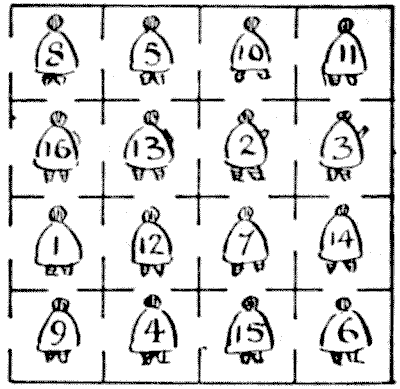
THE SIBERIAN DUNGEONS.—solution

In attempting to solve this puzzle it is clearly necessary to seek such magic squares as seem the most favourable for our purpose, and then carefully examine and try them for "fewest moves." Of course it at once occurs to us that if we can adopt a square in which a certain number of men need not leave their original cells, we may save moves on the one hand, but we may obstruct our movements on the other. For example, a magic square may be formed with the 6, 7, 13, and 16 unmoved; but in such case it is obvious that a solution is impossible, since cells 14 and 15 can neither be left nor entered without breaking the condition of no two men ever being in the same cell together.
The following solution in fourteen moves was found by Mr. G. Wotherspoon: 8-17, 16-21, 6-16, 14-8, 5-18, 4-14, 3-24, 11-20, 10-19, 2-23, 13-22, 12-6, 1-5, 9-13. As this solution is in what I consider the theoretical minimum number of moves, I am confident that it cannot be improved upon, and on this point Mr. Wotherspoon is of the same opinion.
click here to go to my blog.
See more interesting puzzles at http://puzzles.50webs.org